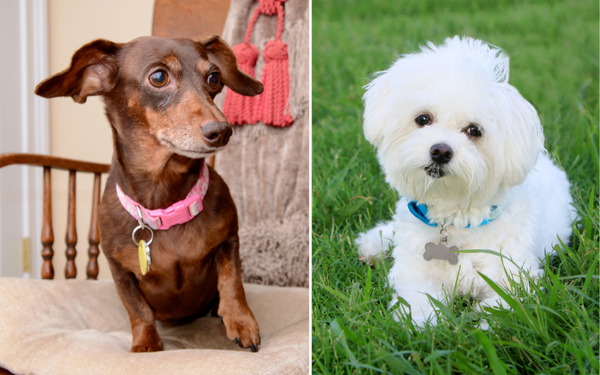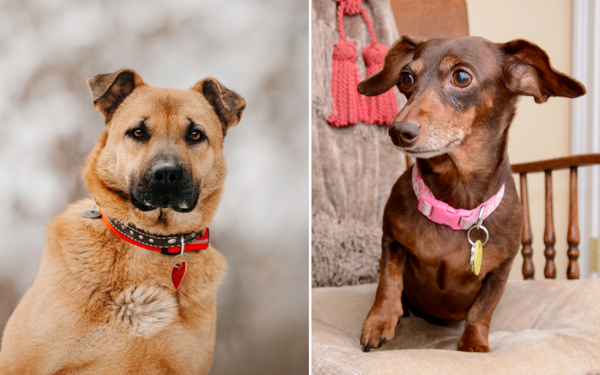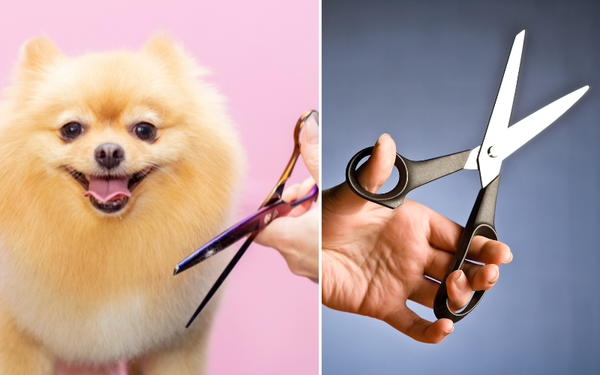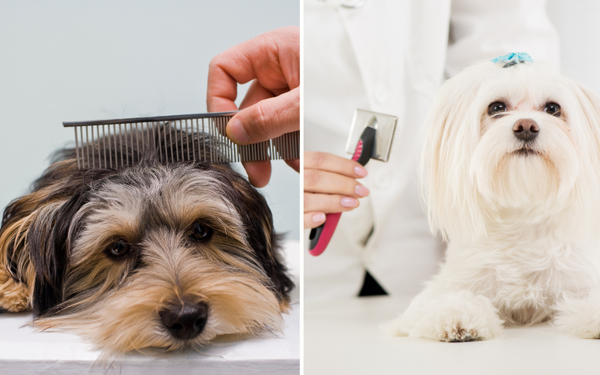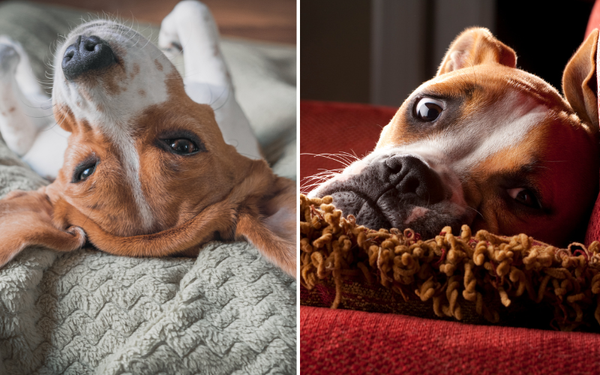As pet owners navigate the convenience of modern pet care, understanding “what are the disadvantages of automatic feeders” is critical. These devices can malfunction, limit your pet’s diet to certain food types, and diminish quality time between you and your furry friend. In this article, we will delve into these important drawbacks to help you decide if automatic feeding aligns with your pet’s needs.
Key Takeaways
- Automatic pet feeders may lack flexibility in dispensing various food types, particularly wet food, and can struggle with providing specific veterinary-prescribed diets or managing special feeding requirements.
- The use of automatic feeders can diminish essential bonding time and interaction between pets and their owners, potentially impacting the pet’s emotional well-being and behavior.
- Automatic feeders can complicate meal monitoring, making it challenging to track food intake and notice uneaten food, which can be critical for identifying health issues or changes in appetite.
Understanding the Limits of Automatic Feeders
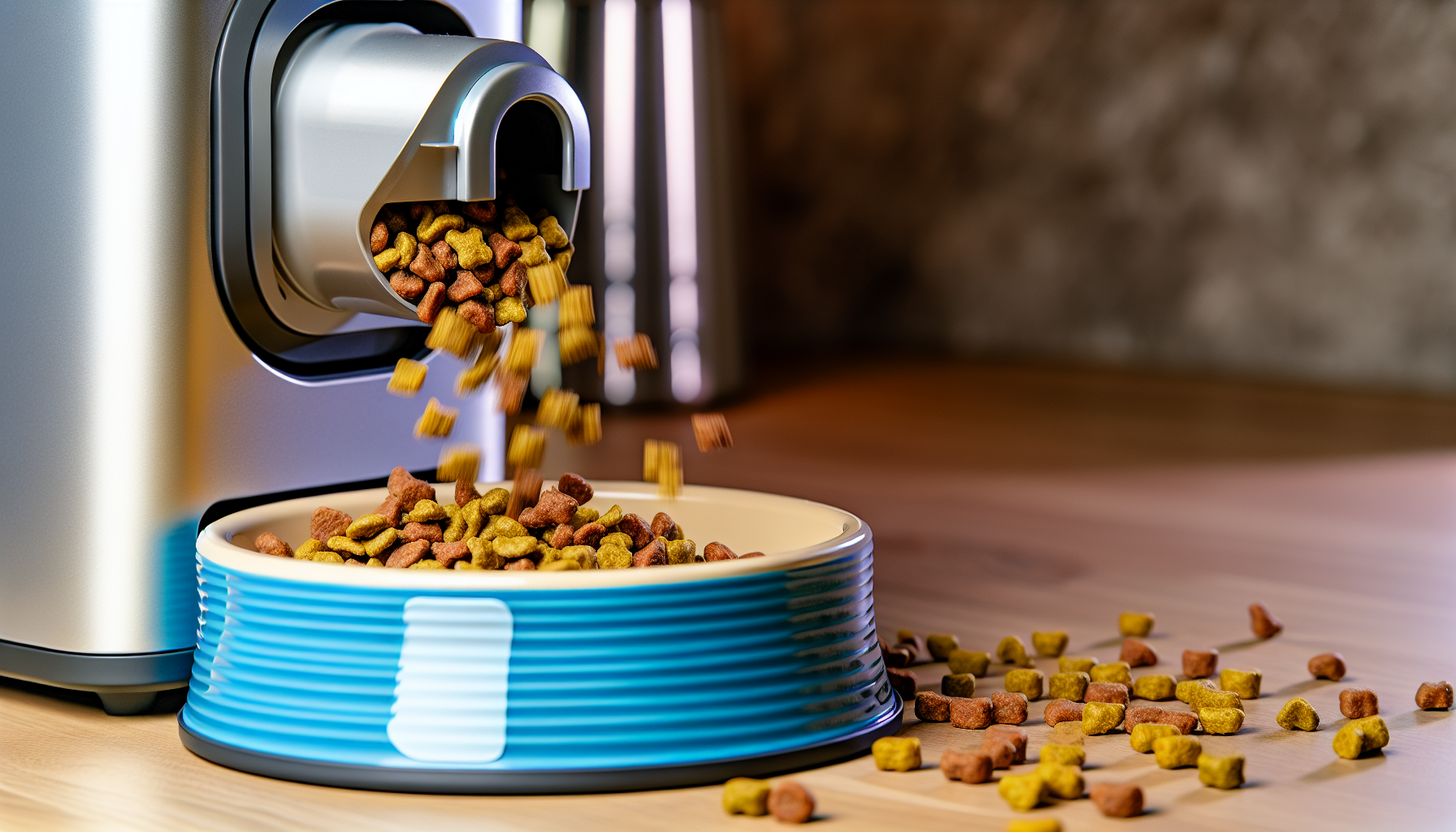
On the surface, automatic pet feeders, such as an automatic dog feeder, seem like a dream come true, dispensing food at set times without the need for human supervision. However, these devices, including automatic pet food dispensers and automatic dog feeders, may not be as beneficial as they initially appear. The limitations of these devices become apparent when you delve a little deeper into their operation and usage.
One drawback is their inability to accommodate different kinds of food. For instance, automatic cat feeders are generally not suitable for wet food, which can cause blockages and malfunctions. Additionally, they may struggle to accommodate a wide range of food varieties, potentially limiting the dietary options for pets, especially those on specific veterinary prescription diets or wet foods.
Incompatibility with Wet Food
The issues with using wet food in automatic feeders primarily stem from its consistency. Wet food’s sticky nature can cause clogging in the dispenser, leading to inconsistent or inaccurate food portioning and potential malfunctions. Furthermore, wet cat food cannot be left out for extended periods, as it needs to be refrigerated and covered to avoid spoilage. There’s also risk of spoilage and wastage if curious cats tip over the feeder to access the food.
Though some automatic feeders are specifically designed for wet food, they aren’t the standard. These tailored feeders, like the ORSDA Automatic Cat Feeder Wet Food, are designed to manage the challenges associated with wet pet food.
Limited Food Varieties
A further downside of automatic feeders is:
- The restricted range of food they can dispense. Most of these feeders are designed to dispense only dry food, which restricts the variety of pet food options available.
- They may not be suitable for wet and semi-moist foods.
- Their capacity to dispense food is often limited.
Moreover, unique diets such as raw food or prescription diets come with particular handling needs. These may include refrigeration or precise portion control. Automatic feeders may not adequately meet these requirements, posing difficulties for pets with dietary restrictions or those requiring controlled portions. As a result, maintaining proper nutrition and portion control can be challenging when using automatic feeders with specialized diets.
The Overlooked Aspect of Feeding: Bonding Time
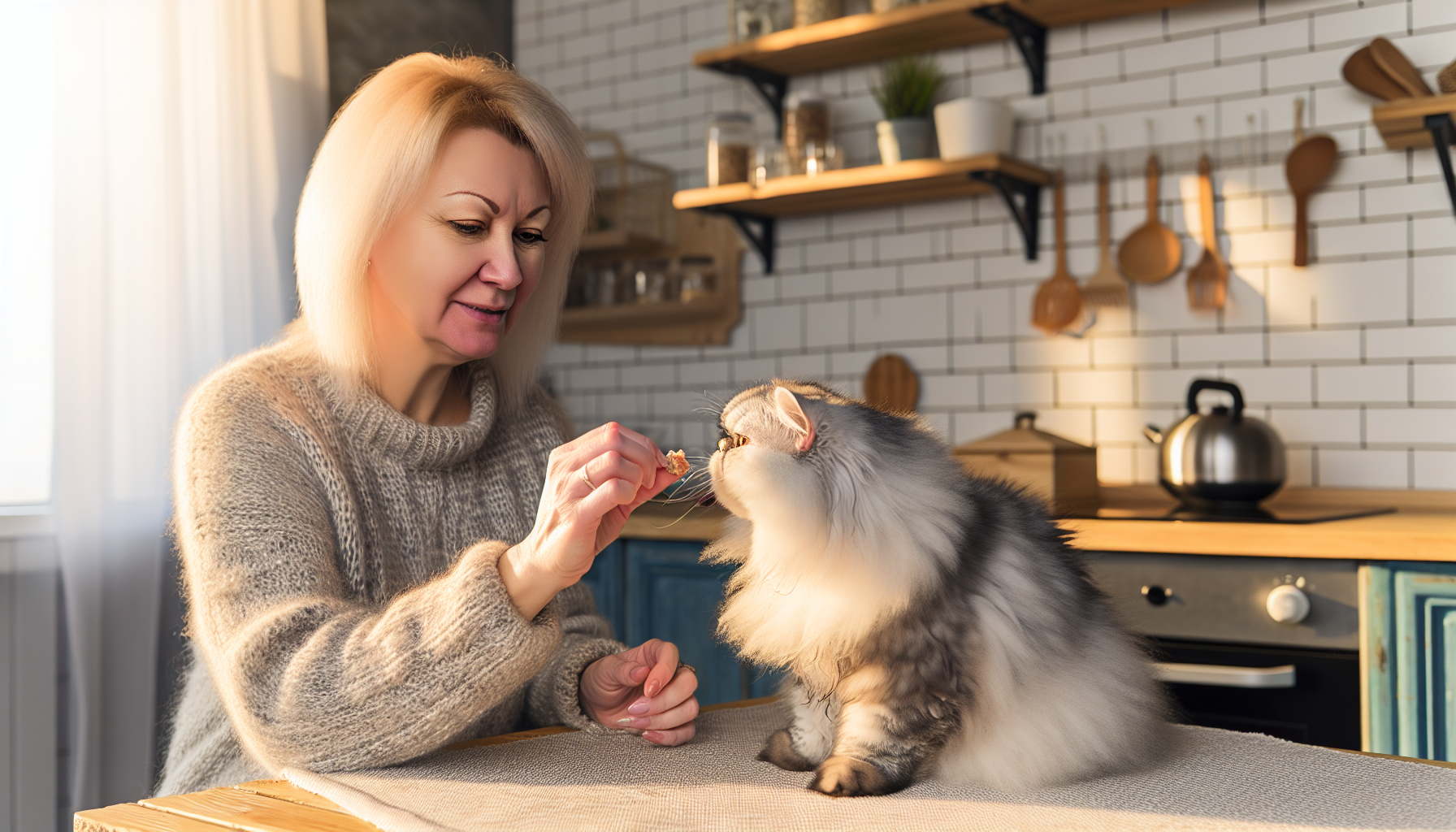
Despite the convenience automatic feeders provide, they often undermine a key facet of feeding – bonding time with pets. The shared activity of mealtime is an opportunity for pets and owners to establish a bond. However, the use of automatic feeders has the potential to reduce opportunities for this meaningful engagement, which can impact the bonding time between pets and owners. It is, therefore, essential to consider this aspect when choosing a feeding method for your pet.
While automatic feeders can be used safely under consistent supervision, they do not entirely replace the human interaction and bonding that occurs during feeding. Therefore, it’s crucial to find a balance that ensures your pet’s dietary needs are met while maintaining a strong human-pet bond.
Reduced Human Contact
A major concern with automatic feeders is the potential decrease in human interaction. Feeding time plays a crucial role in human-pet interaction as it offers a shared activity, bonding opportunity, and fosters a sense of dependency and trust between the human and the pet. However, automatic feeders can decrease the amount of physical contact and interaction between pets and their owners.
The interaction between humans and pets, including cat owners, has a beneficial influence on the well-being of pets, leading to enhanced coping self-efficacy, increased positive emotions, and improved mental and physical health. Diminished interaction during mealtime can negatively impact a pet’s emotional health and may lead to changes in behavior.
Impact on Pet's Behavior
Decreased human contact during feeding can influence a pet’s behavior and emotional health. The absence of human interaction during feeding can detrimentally affect a pet’s emotional well-being, as research indicates that engaging with humans generally has a positive influence on their overall well-being.
Feeding time interaction can impact a pet’s social behavior by reinforcing behaviors associated with receiving food and establishing a regular routine, which are deeply rooted in a pet’s evolution and domestication. Pets may display grumpy behavior and heightened reactivity when they have reduced human contact during meal times.
Monitoring Meals: A Challenge with Feeders
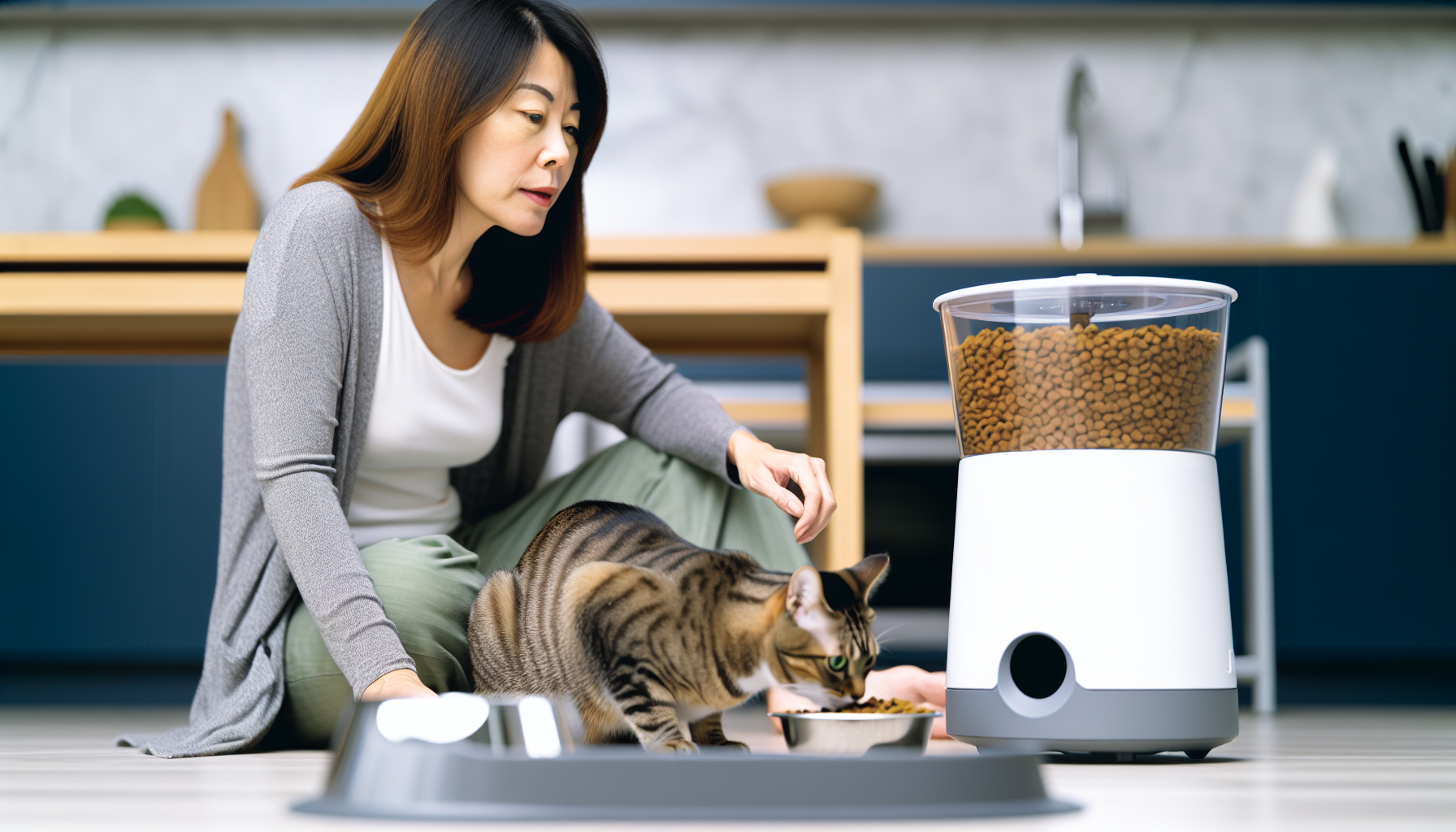
While automatic feeders may appear to be a great solution for feeding your pet in your absence, they come with their own set of challenges, especially regarding meal monitoring. Difficulties in overseeing pet meals when using automatic feeders include the tracking of food intake and detecting uneaten food, which can pose challenges for pet owners in ensuring their pets are consuming their meals adequately.
Relying on an automatic feeder can pose challenges for pet owners in closely monitoring their pet’s eating habits and food intake. This can impede their capacity to notice changes in appetite, recognize early indications of health problems, and modify feeding quantities according to the pet’s individual requirements.
Difficulty Tracking Food Intake
Using automatic feeders can make it difficult to monitor your pet’s food consumption, as the food is dispensed when you’re not around, potentially delaying detection of any changes in their pet’s eating habits or appetite. Proprietors should remain vigilant for indications such as stress or deviation from routine, illness, and alterations in food preference or response to a new food formula or brand, as these can signify changes in a pet’s appetite.
This issue highlights the importance of manual feeding or close monitoring, especially in multi-pet households. Without a watchful eye, it can be nearly impossible to accurately track how much each pet is eating, which can lead to potential health issues.
Risk of Uneaten Food
A major issue with automatic feeders is the likelihood of leftover food. The majority of automatic pet feeders do not possess sensors to detect uneaten food. This can lead to issues such as spoilage, which can pose a health risk to your pet. Furthermore, uneaten food can also signal changes in your pet’s appetite or potential health issues, which can be overlooked if the feeder does not notify the owner.
Therefore, while automatic feeders offer convenience, they may not be the best option for pets with specific dietary needs or those prone to health issues. In such cases, manual feeding or a combination of both may be the preferred option.
Portion Control Pitfalls

Portion control is vital in pet feeding, but automatic feeders, despite their convenience, can occasionally fail in this regard. Inaccurate meal sizes can be caused by technical glitches or misprogrammed portion sizes within the dispenser’s mechanism. Dispensing errors may lead to an inaccurate amount of food being dispensed, potentially exceeding or falling short of the pet’s dietary requirements.
Overfeeding pets with automatic feeders can result in obesity and can have adverse impacts on the pet’s general health and wellness. Immediate consequences of overfeeding may encompass weight gain or a range of digestive issues in the pet.
Inaccurate Meal Sizes
Potential factors that may result in inaccurate meal sizes when using automatic feeders include:
- Selecting the incorrect feeder for your pet’s requirements
- Failing to observe your pet’s feeding habits and behavior
- Neglecting to regularly clean the feeder
- Experiencing inconsistency or inaccuracy in food portioning
It is important to consider these factors to ensure that your pet is receiving the correct amount of food at each mealtime.
Several documented instances of automatic feeders dispensing incorrect meal sizes include:
- Inconsistent dispensing of semi-moist food
- Accuracy problems for quantities under 2 cups
- Misprogrammed portion sizes
- Smart feeders dispensing inaccurate amounts of food
Insufficient feeding can result in negative impacts on their health, such as possible weight reduction and nutritional inadequacies.
Malfunction Risks
Although many automatic feeders are dependable, they always carry a risk of malfunction, especially problems like food jamming. This is a prevalent issue with automatic pet feeders, often leading to disruptions in the feeding schedule and potential overfeeding or missed meals for pets.
To prevent such issues, implementing routine maintenance practices can aid in preventing malfunctions. Here are some tips:
- Regularly clean the feeder components
- Lubricate moving parts as needed
- Check for any loose or damaged parts and repair or replace them
- Choose a feeder equipped with safety features such as a locking lid or anti-jamming mechanism to minimize the potential for pets becoming trapped or injured.
By following these maintenance practices and choosing a feeder with safety features, you can ensure the proper functioning of your pet feeder and minimize the risk of accidents.
The Reliability Question

Even though automatic feeders provide the convenience of feeding your pet in your absence, their reliability can occasionally be questionable. It is crucial to thoroughly test a new automatic feeder before allowing a cat to use it independently, in order to evaluate the potential for malfunctions. Over prolonged periods, feeders may experience wear and tear, or be inadvertently tipped over by inquisitive cats.
Another factor impacting the reliability of automatic feeders is their dependence on power sources. Power outages can have a significant impact on automatic feeders as many of them depend on batteries or electricity, leading to potential missed meals during such outages.
Dependence on Power Sources
Automatic feeders depend on power sources, which can affect their dependability. Power outages can have a significant impact on automatic feeders as many of them depend on batteries or electricity, leading to potential missed meals during such outages. The prevalent power sources utilized for automatic pet feeders are AC to DC power adapters and power adaptors specifically designed for the feeder.
The batteries of automatic pet feeders can typically last up to 30 days with a single charge, but some models can provide more than 180 days of battery life. Some feeders also provide the option to install batteries in the event of a power outage.
Maintenance and Upkeep
Routine maintenance and cleaning of automatic pet feeders are necessary to ensure their optimal functioning and to curb bacterial growth, crucial for the health and safety of pets. Effective maintenance of an automatic pet feeder entails:
- Disconnecting power
- Disassembling feeder components
- Cleaning the stainless steel bowl
- Washing the feeding mechanism
- Disposing of residual pet food
- Replacing any worn or damaged parts
Veterinarians suggest that an automatic pet feeder should be cleaned daily after the pet’s last meal of the day, and a more thorough cleaning should be done at least once a week to reduce the risk of bacterial growth and uphold the feeder’s cleanliness. Failure to properly maintain an automatic pet feeder can result in a range of hazards, such as the build-up of stale food, proliferation of bacteria and mold, mechanical impairment of the feeder, and the risk of overfeeding or underfeeding your pet, which may pose significant health risks.
Alternatives to Solely Using an Automatic Feeder
While automatic feeders bring convenience, it may be beneficial to contemplate other options or additional methods to cater to your pet’s dietary needs while preserving a strong connection with them. Some of these alternatives include integrating manual feeding with an automatic feeder or employing a pet sitter.
Integrating manual feeding with an automatic feeder offers:
- Increased flexibility and control over portion sizes
- Enhanced interaction with pets
- The ability to make necessary dietary adjustments
- Retaining the convenience of an automated system.
Meanwhile, employing a pet sitter in conjunction with an automatic feeder offers the pet:
- essential human attention and interaction
- ensures the effective operation of the feeder
- can also help in managing issues such as preventing aggression among multiple pets sharing the feeder.
Combining Manual and Automatic Feeding
Blending manual and automatic feeding can serve as a balanced approach to offer convenience and sustain a firm bond with your pet. Integrating manual and automatic feeding can offer the benefit of better monitoring of individual feeding behaviors and enhancing the overall health and wellbeing of the pet.
To effectively integrate manual and automatic feeding, it’s essential to select the feeding schedule that is most suitable for your pet and adhere to the instructions given by the automatic pet feeder you are utilizing.
Employing a Pet Sitter
Employing a pet sitter can serve as an excellent alternative or addition to using an automatic feeder. A pet sitter can:
- Provide human attention and interaction
- Ensure the effective operation of the feeder
- Help in managing issues such as preventing aggression among multiple pets sharing the feeder.
A pet sitter’s responsibilities encompass feeding and watering animals, providing companionship, grooming, administering medication, cleaning habitats, reporting health and behavioral concerns, and ensuring the overall well-being and safety of the pets. When employing a pet sitter, it is important to seek out an individual capable of administering medications if needed, possessing relevant qualifications, training, and being associated with a reputable pet sitting organization.
Summary
In summary, while automatic pet feeders have their benefits, they also come with their share of limitations and challenges. They may not be suitable for all pets or for all types of food, and their use can impact the bonding time between pets and their owners. They can pose challenges in monitoring meals and portion control, and their reliability can sometimes be a concern. Therefore, pet owners should consider alternatives such as combining manual and automatic feeding or employing a pet sitter to ensure their pet’s dietary needs are met while maintaining a strong bond with them. The key is to find a balance that works best for you and your pet.
Frequently Asked Questions
What are the disadvantages of automatic fish feeders?
The main disadvantage of automatic fish feeders is that they may drop the food into the overflow box, bypassing the tank and not benefiting the fish. Be mindful of this potential issue when considering an automatic feeder.
Are automatic dog feeders good or bad?
Automatic dog feeders can be a convenient option for busy pet owners, especially for short trips or busy days, but they should never replace your personal care and attention for your pet. While they can work well for pets thriving on a dry food diet with known eating habits, they may not be suitable for all pets.
What are the advantages of automatic fish feeders?
Automatic fish feeders can improve catch rates by attracting fish during feeding times, help balance predator-to-prey ratios, and provide a convenient fishing spot, making them advantageous for fish management and recreational fishing.
Can automatic feeders handle all types of pet food?
No, automatic feeders may not be suitable for all types of pet food, especially wet food, which can cause blockages and malfunctions. They also may not accommodate a wide variety of food types, limiting options for pets with specific dietary needs.
What impact can automatic feeders have on human-pet interaction?
Automatic feeders can reduce physical contact and interaction between pets and their owners, impacting bonding time and a pet's emotional well-being. It's important to balance the convenience of automatic feeders with the need for regular interaction with your pet.
You Might Also Like...






